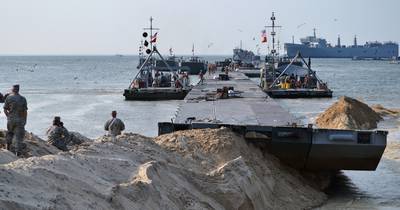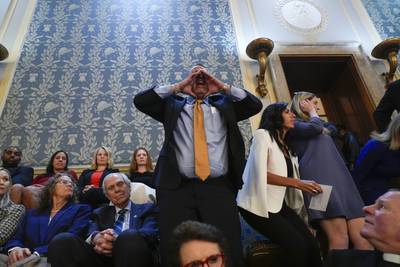Recent reports suggest public accounts of unidentified anomalous phenomena — more commonly called UFOs — were more likely to emerge when civilians were located within 18 miles of a military operations area.
Using publicly available data from the National UFO Reporting Center, researchers from the RAND Corporation found there was a consistent correlation between areas of military operations and public reports of UAP sightings, a RAND researcher said.
“There’s a lot of threats in the sky,” Marek Posard, a social scientist at RAND and author of the report, told Military Times. “Our airspace is massive. We want to leverage public reporting, but we don’t want people reporting our own stuff. And I don’t think a lot of people realize that they are either living under, working under or traveling under these [military operation areas].”
In April, Sean Kirkpatrick, head of the Pentagon’s All-domain Anomaly Resolution Office, told senators that the sightings of unidentified aerial phenomena had surged by more than 140 since the last report was released in January. RAND researchers did not have access to the details surrounding those sightings, which forced them to find a publicly available database.
“Of those over 650 [UAPs], we’ve prioritized about half of them to be of anomalous, interesting value,” Kirkpatrick said in April.
In their report, RAND researchers found the rate of UAP sightings to be 1.2 times greater within 18 miles of a military operations area than the report prevalence beyond that distance.
The RAND report comes as the House Oversight Committee is scheduled to hold a hearing on unidentified anomalous phenomena on Wednesday. Multiple U.S. Navy pilots who experienced phenomena flying through the skies are expected to testify, as is intelligence community whistleblower David Grusch, who made unsubstantiated claims that extraterrestrial aircraft are being hidden from the rest of the government.
Researchers of the RAND report, meanwhile, said they had limited understanding of how the National UFO Reporting Center judged whether a UAP sighting was legitimate or not. Also, researchers were unable to say whether numerous individuals had reported the same UAP, or if each instance indicated a different phenomena.
Despite the limitations, Posard said researchers recommended further studies on how to best create a public space where civilians can report phenomena and where information can be better disseminated. Other recommendations include notifying civilian populations about airspace activity over areas of military operations.
“It doesn’t mean that the report is this end all be all,” Posard said. “This is more of a starting point in the discussion: Are there any geographic areas where we’re seeing this stuff? Are there any kind of potential explanations for these next steps?”
Kirkpatrick noted during the hearing that AARO is planning to develop a website where members of the public can document experiences with UAPs, adding that the initial design for the website has been in the review process since before Christmas of last year.
Zamone “Z” Perez is a rapid response reporter and podcast producer at Defense News and Military Times. He previously worked at Foreign Policy and Ufahamu Africa. He is a graduate of Northwestern University, where he researched international ethics and atrocity prevention in his thesis. He can be found on Twitter @zamoneperez.





